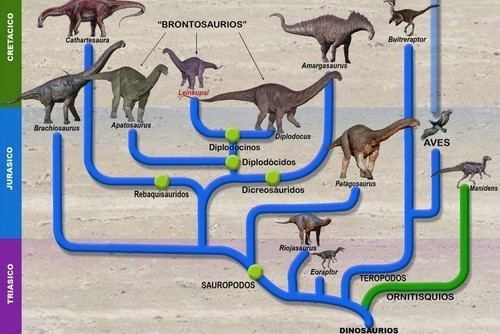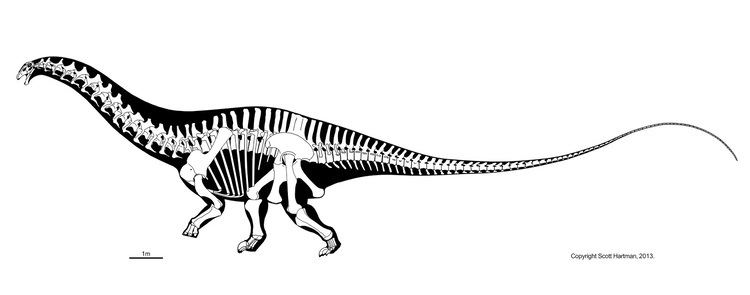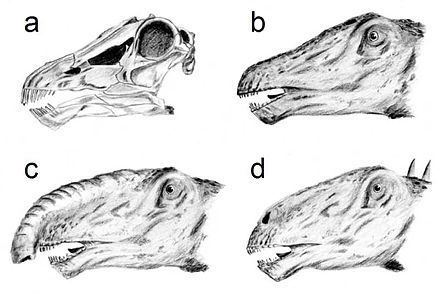Kingdom Animalia Clade Dinosauria Suborder †Sauropodomorpha Scientific name Diplodocidae Rank Family | Phylum Chordata Order Saurischia Clade †Neosauropoda Higher classification Flagellicaudata | |
 | ||
Lower classifications Diplodocus, Apatosaurus, Brontosaurus, Supersaurus, Barosaurus | ||
Diplodocids, or members of the family Diplodocidae ("double beams"), are a group of sauropod dinosaurs. The family includes some of the longest creatures ever to walk the Earth, including Diplodocus and Supersaurus, some of which may have reached lengths of up to 34 metres (112 ft).
Contents

DescriptionEdit

While still massive, when compared to the titanosaurids and brachiosaurs, the diplodocids were relatively slender but extremely long. They had short legs, making them the "dachshund" of giant dinosaurs; and their rear legs were longer than front legs, giving their back a distinctive downward slope towards the neck.

Their necks were also extremely long. According to recent computer simulations, they may not have been able to lift their necks like other sauropods. However, these simulations do not take vertebral cartilage into account, which would likely allow a greater range of motion. Instead of reaching up into trees, they may have used their necks to graze over a broad area. They may also have used their necks to reach into dense stands of conifers, or over marshy ground.

Their heads, like those of other sauropods, were tiny with the nasal openings on the top of the head (though in life the nostrils themselves would have been close to the tip of the snout). Their teeth were only present in the front of the mouth, and looked like pencils or pegs. They probably used their teeth to crop off food, without chewing, and relied on gastroliths (gizzard stones) to break down tough plant fibers (similar to modern birds).
The heads of diplodocids have been widely depicted with the nostrils on top due to the position of the nasal openings at the apex of the skull. There has been speculation over whether such a configuration meant that diplodocids may have had a trunk. A 2006 study surmised there was no paleoneuroanatomical evidence for a trunk. It noted that the facial nerve in an animal with a trunk, such as an elephant, is large as it innervates the trunk. The evidence suggests that the facial nerve is very small in diplodocids. Studies by Lawrence Witmer (2001) indicated that, while the nasal openings were high on the head, the actual, fleshy nostrils were situated much lower down on the snout.
Diplodocids also had long, whip-like tails, which were thick at the base and tapered off to be very thin at the end. Computer simulations have shown that the diplodocids could have easily snapped their tails, like a bullwhip. This could generate a sonic boom in excess of 200 decibels, and may have been used in mating displays, or to drive off predators. There is some circumstantial evidence supporting this as well: A number of diplodocids have been found with fused or damaged tail vertebrae, which may be a symptom of cracking their tails.
SkinEdit
Few skin impressions of diplodocids have been found. However, at least one significant find was reported by Stephen Czerkas in 1992. Fossils from the Howe Quarry in Shell, Wyoming preserved portions of the skin from around the tip of the tail, or "whiplash". Czerkas noted that the skin preserved a sequence of conical spines, and that other, larger spines were found scattered around larger tail vertebrae. The spines appeared to be oriented in a single row along the mid-line of the tail, and Czerkas speculated that this midline row may have continued over the animal's entire back and neck.
GrowthEdit
Long-bone histology enables researchers to estimate the age that a specific individual reached. A study by Griebeler et al. (2013) examined long bone histological data and concluded that the diplodocid MfN.R.2625 weighed 4,753 kilograms (5.2 short tons), reached sexual maturity at 23 years and died at age 24. The same growth model indicated that the diplodocid MfN.R.NW4 weighed 18,463 kilograms (20.4 short tons), and died at age 23, before reaching sexual maturity.
ClassificationEdit
Diplodocidae was the third name given to what is now recognized as the single family of long-necked, whip-tailed sauropods. Edward Drinker Cope named the family Amphicoeliidae in 1878 for his genus Amphicoelias, sometimes considered a diplodocid. However, the name Amphicoeliidae did not come into wider use and was not used in the scientific literature after 1899, making it a nomen oblitum ("forgotten name") according to the ICZN, preventing it from displacing the name Diplodocidae as a senior synonym. More recent studies have also shown that Amphicoelias itself does not belong to this family, but is instead a more primitive diplodocoid. A similar situation occurred for the family name Atlantosauridae, named by Othniel Charles Marsh in 1877, and which Hay argued had priority over Amphicoelidae. George Olshevsky declared Atlantosauridae a nomen oblitum in 1991, though scientists such as Steel and Nowinski had treated Atlantosauridae as a valid name as late as 1971, and the former even added a subfamily, Atlantosaurinae.
Some dinosaurs have been considered diplodocids in the past but have not been found to be members of that group in later, larger analyses of the family's relationships. Australodocus, for example, was initially described as a diplodocid, but may actually have been a Macronarian. Amphicoelias was traditionally been considered a diplodocid due to its similar anatomy, but phylogenetic studies showed it to be a more basal member of the Diplodocoidea.
The relationships of species within Diplodocidae has also been subject to frequent revision. A study by Lovelace, Hartman and Wahl in 2008 found that Suuwassea and Supersaurus were relatives of Apatosaurus, within the subfamily Apatosaurinae. However, a subsequent analysis by Whitlock in 2011 showed that Supersaurus is slightly closer to Diplodocus than to Apatosaurus, and that Suuwassea is actually a primitive dicraeosaurid.
The subfamily Diplodocinae, was erected to include Diplodocus and its closest relatives, including Barosaurus. The Portuguese Dinheirosaurus and the African Tornieria have also been identified as close relatives of Diplodocus by some authors.
Cladogram of the Diplodocidae after Tschopp, Mateus, and Benson (2015).
Distinguishing anatomical featuresEdit
A diagnosis is a statement of the anatomical features of an organism (or group) that collectively distinguish it from all other organisms. Some, but not all, of the features in a diagnosis are also autapomorphies - distinctive anatomical features that are unique to a given organism or group.
The clade Diplodocidae is distinguished based on the following characteristics:
